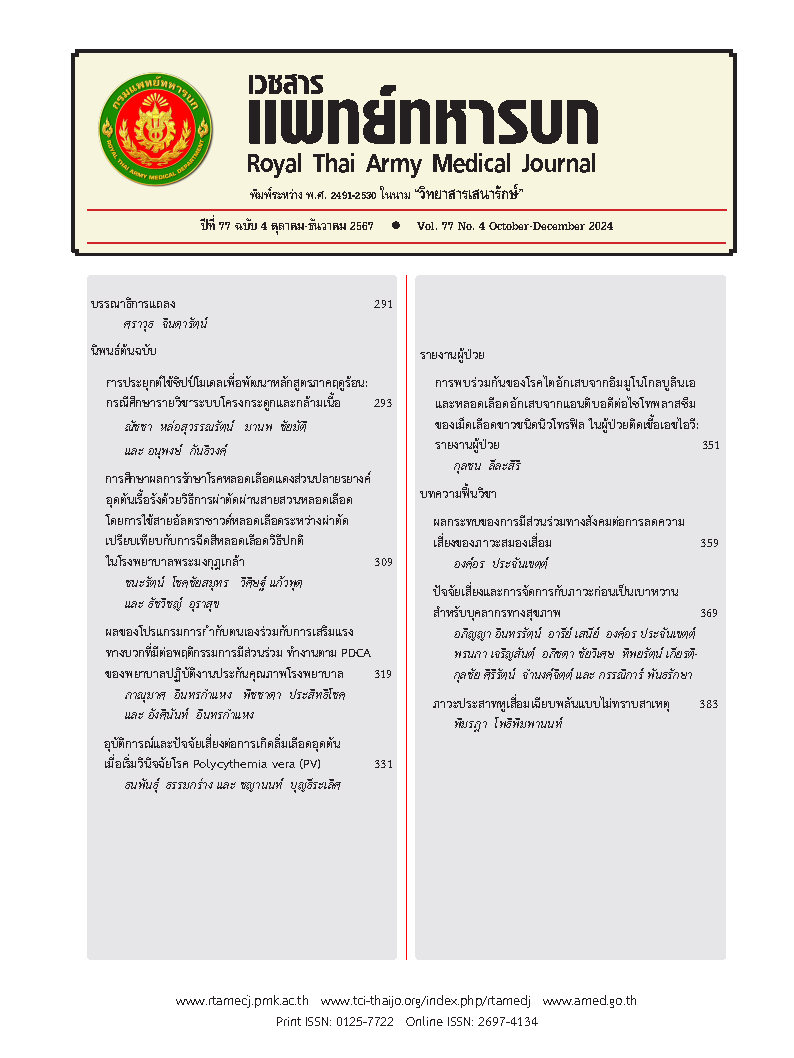การประยุกต์ใช้ซิปป์โมเดลเพื่อพัฒนาหลักสูตรภาคฤดูร้อน: กรณีศึกษารายวิชาระบบโครงกระดูกและกล้ามเนื้อ
Main Article Content
บทคัดย่อ
บทนำ จากการเก็บข้อมูลต่อเนื่อง 3 ปีย้อนหลัง พบว่ามีีจำนวนนักเรียนที่สอบไม่่ผ่านเกณฑ์ในรายวิชาระบบโครงกระดูกและกล้ามเนื้อ 1 เป็นจำนวนมาก การศึกษานี้จึงต้องการนำซิปป์โมเดลมาประยุกต์ใช้้ในการวางแผนพัฒนาหลักสูตร เพิ่มประสิทธิิภาพการจัดการเรียนการสอนภาคฤดูร้อนสำหรับสอบแก้้ตัว วิธีการศึกษา เป็นการศึกษานำร่อง และการศึกษาระยะสั้นเชิงพรรณนา โดยประเมินทั้ง 4 ด้านของซิปป์ คือ ด้านบริบท ปัจจัยนำเข้า กระบวนการ และผลผลิต เพื่อวางรากฐานการแก้ปัญหา วางแผนการพัฒนาหลักสูตร เลือกรููปแบบการเรียนที่เหมาะสม เพื่อให้นักเรียนที่่อยู่่ในกลุ่มนี้ มีีความรู้้ทางกายวิภาคศาสตร์ในเรื่องที่สำคัญและมีีความจำเป็น เพียงพอในการนำไปใช้้ต่อยอดในการเรียนชั้นที่สูงขึ้นไป โดยเฉพาะทางด้านศัลยศาสตร์์ เวชศาสตร์์ฟื้นฟูู และโสต ศอ นาสิก เก็บข้อมูลโดยใช้้แบบสอบถาม และการอภิปรายร่วมกัน จากนั้นนำข้อมูลที่ได้้มาวิเคราะห์์ทางสถิติ ผลการศึกษา ข้อมูลที่ได้้จากอาจารย์ทางคลินิก อาจารย์ปรีคลินิก และนักเรียนแพทย์์จำนวนทั้งสิ้น 161 คน ได้้ถูกนำมาใช้้ในการกำหนดหัวข้อการสอน และรููปแบบการเรียนที่่เหมาะสมสำหรับการเรียนเสริมทักษะในภาคฤดูร้อน พบว่านักเรียนมีีความพึงพอใจต่อหลักสูตรนี้ในระดับดีี ( = 4.49, SD = 0.05) และอาจารย์ทางคลินิกมีีความพึงพอใจต่อผลผลิต นักเรียนแพทย์์ที่จบหลักสูตรในระดับดีี (
= 4.14, SD = 0.17) สรุป ซิิปป์โมเดลสามารถนำมาใช้้ในการวางแผนพัฒนาและแก้้ปัญหาหลักสูตรได้้อย่างมีประสิทธิิภาพและเป็นระบบ โดยนอกจากจะคำนึงถึงความถนัดและทัศนคติิของผู้้เรียนแล้ว ยังคำนึงถึงความคิดเห็นของอาจารย์ผู้้สอน และความต้องการของอาจารย์แพทย์์ในชั้นคลินิกที่เกี่ยวข้องอีกด้วย
Downloads
Article Details

อนุญาตภายใต้เงื่อนไข Creative Commons Attribution-NonCommercial-NoDerivatives 4.0 International License.
บทความในวารสารนี้อยู่ภายใต้ลิขสิทธิ์ของ กรมแพทย์ทหารบก และเผยแพร่ภายใต้สัญญาอนุญาต Creative Commons Attribution-NonCommercial-NoDerivatives 4.0 International (CC BY-NC-ND 4.0)
ท่านสามารถอ่านและใช้งานเพื่อวัตถุประสงค์ทางการศึกษา และทางวิชาการ เช่น การสอน การวิจัย หรือการอ้างอิง โดยต้องให้เครดิตอย่างเหมาะสมแก่ผู้เขียนและวารสาร
ห้ามใช้หรือแก้ไขบทความโดยไม่ได้รับอนุญาต
ข้อความที่ปรากฏในบทความเป็นความคิดเห็นของผู้เขียนเท่านั้น
ผู้เขียนเป็นผู้รับผิดชอบต่อเนื้อหาและความถูกต้องของบทความของตนอย่างเต็มที่
การนำบทความไปเผยแพร่ซ้ำในรูปแบบสาธารณะอื่นใด ต้องได้รับอนุญาตจากวารสาร
เอกสารอ้างอิง
Rohen JW, Yokochi C, Drecoll EL. Color Atlas of Anatomy. 7th ed. Germany: Lippincott Williams & Wilkins/A Wolters Kluwer Company; 2011.
Standring S. Gray’s Anatomy: The Anatomical Basis of Clinical Practice. 41st ed. Elsevier; 2016.
Netter FH. Atlas of Human Anatomy. 7th ed. Philadelphia: Elsevier Saunders; 2019. Available from: https://www.clinicalkey.com
Stufflebeam DL, Shinkfield AJ. Evaluation: Theory, models and applications. San Francisco, CA: Jossey-Bass; 2007.
Patphol, M. Curriculum evaluation for learning and development. 3rd ed. Bangkok: Charansanitwong Printing Co., Ltd.; 2015. Thai.
Iramaneerat C, Rangsisombatsiri C. Satisfaction Survey of Graduates from the Doctor of Medicine Program of the Faculty of Medicine Siriraj Hospital. Siriraj Medical Bulletin. 2010;3(2):86-99. Thai.
Kaewpila P, Prakongsilpa Y. Evaluation of Doctor of Medicine Program B.E. 2540. Journal of Education Graduate Studies Research. Khon Kaen University. 2012;6(2):97-105. Thai.
Damrongkijkosol C, Methapatra P, Stirayakorn P. The Development of Instructional Course Evaluation System for Institution under the Commission of Vocational Education. The Journal of Faculty of Applied Arts, King Mongkut’s University of Technology North Bangkok. 2015;8(1):80-8. Thai.
Chintapanyakun T, Ruaengsri S, Laksana K, Lhongsap P. The New Curriculum Evaluation: CIPPI EST Model. Journal of police nurses. 2017;9(2): 203-12. Thai.
Buasri T. Curriculum theory: Design and development. 2nd ed. Bangkok: Pattanasuksa Printing; 1999. Thai.
Srisaad B. Basic Research. 9th ed. Bangkok: Suweeyasarn; 2013. Thai.
Suttidej J, Boonyasopon T, Mathapatara P, Ratchusanti S. Development of Training Program on Vocational Education Qualification Framework of Subject Area in the Bachelor of Technology Degree Program under the Office of Vocational Education Commission. The Journal of King Mongkut’s University of Technology North Bangkok. 2012; 22(2):377-84. Thai.
Stufflebeam DL. The CIPP model for evaluation, in Kellaghan T, Stuffelebeam DL, editors. International Handbook of Educational Evaluation. Netherland: Kluwer Academic Publishers;2003. p. 31-62.
Watanasuntorn K. Application of Stufflebeam’s CIPP Model for Educational Project Evaluation. Suranaree Journal of Social Science. 2008;2(1): 67-83. Thai
World Agroforestry Center. The CIPP evaluation model [Internet]. 2015. [Cited 2015 Jan 16]. Available from: http://www.cglrc.cgiar.org/icraf/toolkit/default.htm#The_CIPP_evaluation_model.htm
Wanphet W. The quality assessment for development of strategic plan, Faculty of industrial technology in Rajabhat University. Faculty of Industrial Technology, Pranakhon Rajabhat University, Thailand. International Conference: The COMSA 2016: The 2nd conference on Management and Sustainability in Asian, 2016 on September 1-3, Hiroshima, Japan; 2016.
Thongtaninkwan R, Inted W, Thamta A, Boonkaew J, Jaiwandee W, Harnsiriwattanakit K, et al. Factors related to human gross anatomy knowledge retention in medical students. Chula Med J .2018; 62(3):593-605. Thai.
Nuallaong W. How to instruct the Generation Y medical students, Bangkok: Thammasat Medical Journal, .2010; 10(3):381-6. Thai.
Rangchaikul W. Project Evaluation: Concept and Practice. 8th ed. Bangkok: Chulalongkorn University Press; 2013. Thai.


